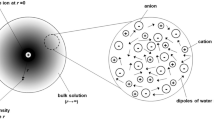Abstract
The calculation of non steady state chloride diffusion coefficients by migration tests is a quite controversial subject due on one hand, to the complexity found in describing the penetration of chlorides and on the other hand, to the fact that the different researchers calculate them by different procedures. Therefore, in present work, experimental trials have been carried out performing migration tests following ASTM C1202-91 procedure, and modified by applying 12 Volts. Results from migration methods have been compared with natural diffusion results from tests that were performed in two different experimental conditions. From these tests, calculations of non-steady-state diffusion coefficients, Dns, have been carried out, resulting that migration tests give results in the same order of magnitude than those obtained from natural diffusion tests. However, as it is not known how far the diffusion tests reproduce the real conditions, it has been concluded that, in the lack of a reference method reproducing realistic conditions, either diffusion or migration tests cannot be used more than for comparative purposes. Further research is needed on development of tests able to reproduce real performance.
Résumé
Le calcul du coefficient de diffusion des chlorures en régime non-stationnaire par des essais de migration est un sujet assez controversé en raison, d'une part, de la complexité que présente la description de la pénétration des chlorures et, d'autre part, du fait que les différents chercheurs utilisent des procédés de calcul différents. C'est pourquoi dans ce travail, les essais expérimentaux e performance ont été menés selon la méthode ASTM C1202-91, et modifiés par l'application d'un potentiel de 12 volts. Les résultats obtenus par méthodes de migration ont été comparés aux résultats obtenus avec des essais de diffusion naturelle effectués sous deux conditions expérimentales différentes. À partir de ces essais, le calcul des coefficients de diffusion en régime non-stationnaire, Dns, a été effectué. Il en résulte que les essais de migration donnent des résultats du même ordre de grandeur que ceux obtenus avec les essais de diffusion naturelle. Cependant, puisque l'on ne sait pas dans quelle mesure les essais de diffusion sont représentatifs des conditions réelles, l'étude arrive à la conclusion que, faute d'une méthode de référence reproduisant les conditions réelles, ni les essais de migration, ni ceux de diffusion ne peuvent être utilisés au-delà d'une simple comparaison. D'autres travaux sont nécessaires pour développer des essais capables de reproduire les performances réelles.
Similar content being viewed by others
References
Tuutti, K., ‘Corrosion of steel in concrete’, (CBI), Report Fo 4.82, Stockholm, (1982).
Whiting, D., ‘Rapid determination of the chloride permeability of concrete’, Federal Highway Administration. Report no. FHWA/RD-81/119, (1981).
Page, C. L., Short, N. R. and Tarras, A., ‘Diffusion of chloride ions in hardened cement pastes’,Cement and Concrete Research 11 (3) (1981) 395–406.
Andrade, C., ‘Calculation of chloride diffusion coefficients in concrete from ionic migration measurements’,Ibid. 23 (3) (1993) 724–742.
Ollivier, J.-P., Arsenault, J., Truc, O. and Marchand, J., ‘Mario collepardi Symposium on Advances in Concrete Science and Technology’, Rome, (1997).
MacDonald, K. A. and Northwood, D. O., ‘Experimental measurements of chloride ion diffusion rates using a two-compartment diffusion cell: Effects of material and test variables’,Cement and Concrete Research 25 (7) (1995) 1407–1416.
Gilleece, P. R. V., Basheer, A. E. and Long, A. E., ‘The effect of concentration on the accelerated chloride ion migration tests for modified concretes’, Proceedings of the International RILEM Workshop, St-Rémy-les-Chevreuse, France (1995) pp 161.
Tang, L. and Nilsson, L. O., ‘Rapid determination of the chloride diffusivity in concrete by applying an eléctrical field’,ACI Materials Journal Technical Paper, (1992) 49–53.
Andrade, C., Sanjuán, M. A., Recuero, A. and Río, O., ‘Calculation of chloride diffusivity in concrete from migration experiments in non steady-state conditions’,Cement and Concrete Research 24 (7) (1994) 1214–1228.
Collepardi, M., Marcialis, A. and Turriziani, R., ‘Kinetics of penetration of chloride ions into the concrete’,Il cemento 4 (1970) 157–164.
Andrade, C., Castellote, M., Alonso, C. and González, C., ‘comparison of testing methods on chloride diffusion into concrete’, Proceedings of European Conference EUROMAT'98, Lisboa (Portugal), (July 1998).
Castellote, M., ‘Application of electrical fields for the characterisation of concrete in relation to chloride ions transport’, pH'D, University of Zaragoza (Spain) (1997) (only available in the original language).
Crank, J., ‘The mathematics of diffusion’, Ed. Oxford University, (1975).
Keister, J. C. and Kasting, G. B., ‘Ionic mass transport through a homogeneous membrane in the presence of a uniform electrical field’,Journal of Membrane Science 29 (1986) 155.
Castellote, M., Andrade, C., and Alonso, C., ‘Chloride binding isotherms in concrete submitted to non-steady-state migration experiments’, accepted for publication inCement and Concrete Research.
Bamfort, P. B. and Price, W. F., ‘Concrete 2000, Economic and durable construction through excellence, E&F Spon, Dundee, Vol 2, pp 1105–1118, September 1993.
Cook, D. J., Hinczak, I., Jedy, M. and Cao, H. T., Proceedings of 3rd International Conference on ‘Fly Ash, Silica Fume, Slag and Natural Pozzolans in Concrete’, ACI SP-114, pp 1467–1483, 1989.
Andrade, C., Castellote, M., Sarría, J., Alonso, C. and Menéndez E., ‘Effect of Electrochemical Rehabilitation Techniques in the porous microestructure of concrete’, International Conference on Corrosion and Rehabilitation of Reinforced Concrete Structures Orlando, Florida (EEUU), December, 1998.
Author information
Authors and Affiliations
Additional information
Dr. Carmen Andrade is Vice-President of RILEM and a RILEM Fellow. She is the Chairlady of RILEM TC 154-EMC: ‘Electrochemical techniques for measuring metallic corrosion’ and of RILEM TC 178-TMC: ‘Testing and modelling chloride penetration in concrete’. She is also Director of CSIC, a Titular Member. Dr. Castellote is a member of RILEM TC 178-TMC. Dr Alonso is a RILEM Senior Member and participates to the work of RILEM TC 154-EMC.
Rights and permissions
About this article
Cite this article
Andrade, C., Castellote, M., Alonso, C. et al. Non-steady-state chloride diffusion coefficients obtained from migration and natural diffusion tests. Part I: Comparison between several methods of calculation. Mat. Struct. 33, 21–28 (2000). https://doi.org/10.1007/BF02481692
Received:
Accepted:
Issue Date:
DOI: https://doi.org/10.1007/BF02481692




